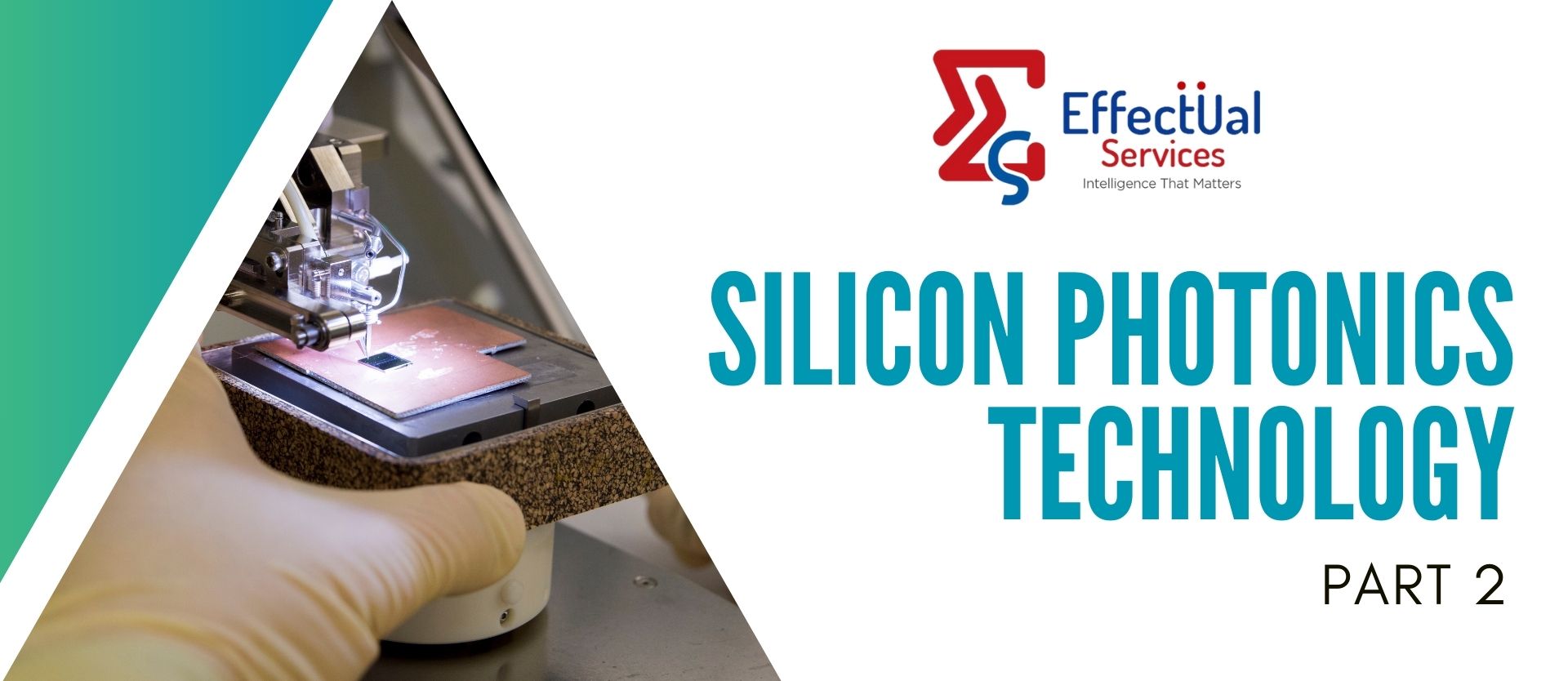Silicon Photonics Technology

Compact optical transceiver by hybrid multichip integration
A compact optical transceiver is formed by coupling a driver and transimpedance amplifier module chips with passive TSV interposers on separate substrates. By decoupling partially photonics, electronics, and interposer processes, achieves low parasitic between driver/TIA and Si photonics devices. A Si-photonics die including pre-fabricated suspended couplers, modulator, photo diodes and electrical connection pads on top surface for mounting laser diodes, is provided.
- The solution address the limitations of traditional communication transmission systems, such as bandwidth and transmission speed restrictions, by introducing a compact optical transceiver based on silicon photonics using hybrid multichip stacking without wire bonds.
- The solution relates to provides an optimized bump design for reducing capacitance of bumps and associated conductive pads that bond the top die for Driver or TIA module and bottom die for Si-photonics chip.
- The solution lies in the hybrid integration approach, where a compact optical transceiver is formed by coupling a driver and trans impedance amplifier module chips with passive TSV interposers on separate substrates.
- By decoupling partially photonics, electronics, and interposer processes, it achieves low parasitic between driver/TIA and Si photonics devices.
One or more laser diodes are coupled to the Si-photonics die to have the laser light being guided through Si-waveguides in the Si-photonics die and coupled to optical fibers supported by pre-fabricated V-grooves.
Application
- The solution is suitable for communication transmission system for higher bandwidth and faster communication transmission .
- The demand for higher bandwidth and faster communication transmission has increased, making optical fiber communication systems more favorable for modern applications requiring mass information transmission.
Comment
- The solution offers a more practical and cost-effective solution for achieving advanced integration of electronics and photonics in high-speed optical transceivers.
- By utilizing separately fabricated TSV/TGV interposers and a staggered bump arrangement with optimized pitch size, the solution provides improved communication bandwidth beyond Moore's Law.
- The integration method used in this solution minimizes parasitic effects, increases production yield, and enhances the overall performance of optical transceivers for various applications, including high-speed optical communication systems.
Compact optical module integrated for communicating cryptocurrency transaction
The optical transceiver includes a driver chip flip-bonded partially on the Si-photonics chip through a first sets of bumps and partially on the first TSV interposer through a second sets of bumps. The optical transceiver also includes a Si-photonics chip attached on a PCB. Additionally, the optical transceiver includes a first TSV interposer and a second TSV interposer separately attached nearby the Si-photonics chip on the PCB.
- The solution relates to a photonic transceiver design and manufacture to improve optimizing optical communication devices.
- It provides a solution for modern communication needs by integrating electronics and photonics for improved performance and security.
- The method provides an optimized bump design for reducing capacitance of bumps and associated conductive pads that bond the top die for Driver or TIA module and bottom die for Si-photonics chip.
- The solution offers a more cost-effective and scalable solution for high-speed optical transceivers.
- The optimization of bump structure is suitable for mass production.
The Si-photonics die plus the mounted laser diodes is disposed on the PCB. The bonding of these components on the PCB is performed by soldering using bigger sized bumps connected to interconnection lines inside the PCB organic substrate.
Application
- A silicon photonics based optical module by hybrid multichip integration is used for storing cryptocurrency and communicating peer-to-peer transaction.
- Such peer-to-peer transactions are used in a variety of applications such as digital currency transaction.
Comment
- The solution provides an optimized bump design for reducing capacitance of bumps and associated conductive pads that bond the top die for Driver or TIA module and bottom die for Si-photonics chip.
- The bump design includes several features that achieve higher performance of smaller bump using bump diameter as large as 50 μm in an optimized arrangement.
OPTO-Electronic Read Head
The opto-electronic chip, comprises a light emitting diode and photo sensitive elements, fabricated in a common semiconductor (e.g. from the III-V family). The flip chip bonding assembly uses bumping and attaching methods, such as solder bumping and reflow processes. The bonds are made using thermo-compression bonding techniques.
- The solution relates to an opto-electronic encoder readhead used to detected displacement relative to a scale.
- The solution involves the utilization of a lattice matched semiconductor compound to fabricate a light source and an array of photodetector elements on a substrate.
- The approach allows for the integration of these components in a compact manner, with the light source emitting light at a specific wavelength for optimal detection by the photodetectors.
- The stand-off space between the opto-electronic chip and substrate, in the case of flip chip bonding, created by the height of the bumps, filled using suitable underfill.
- Underfill can improve the mechanical integrity of the bonded structures thus improving the reliability of the bumps.
The readhead includes an opto-electronic chip comprising a light source for producing light rays; an index grating illuminated by the light source serving as a secondary light source array for producing light rays incident on the scale,
The integrated photonic device is bonded using known bonding techniques, such as flip chip bonding to a substrate (e.g. ASIC, glass carrier or ceramic circuit board).
Application
- The application of silicon photonics is an opto-electronic encoder readhead used to detected displacement relative to a scale.
- The application relates to integration and layout of opto-electronic components.
Comment
- The opto-electronic chip comprises a light emitting diode and photo sensitive elements fabricated in a common semiconductor e.g. Indium Phosphide (InP),
- The encoder readhead offers advantages such as compactness, accuracy, and efficiency.
Coupling alignment device and method for laser chip and silicon-based optoelectronic chip
A high precision alignment flip-chip bonding is accomplished through the shape design of the bumps/grooves, reducing the proportion of coupling related losses of the silicon-based optoelectronic chip occupying the overall device consumption.
The innovative approach not only enhances the reliability of coupling alignment but also paves the way for achieving mass production and cost efficiency in the optoelectronic device industry.
- The solution relates to significantly improve the coupling alignment efficiency and accuracy of laser chips and silicon-based optoelectronic chips.
- This effectively reduce the coupling alignment cost while ensuring the reliability of coupling alignment, improve the packaging efficiency, and achieve a normalized mass production package.
- The solution addresses the issue of low coupling accuracy and high packaging costs in the integration of laser chips with optoelectronic chips.
- The solution significantly reduces the complexity of the packaging process, leading to higher efficiency, precision, and cost-effectiveness in the coupling alignment of laser chips and optoelectronic chips.
A coupling alignment device and method that involves aligning and contacting the laser chip and optoelectronic chip with a transfer mold, transferring the laser chip to an accommodating chamber of the optoelectronic chip, and completing the transfer package.
Application
- The solution relates to silicon-based optoelectronic device packaging.
- More specifically, it relates to a coupling alignment device and method for a laser chip and a silicon-based optoelectronic chip.
Comment
- The solution reducing the final packaging cost of silicon-based optoelectronic chips and laser chips.
- The solution offers higher coupling accuracy, lower packaging costs, and improved efficiency in the integration of laser chips with optoelectronic chips.
Silica-on-silicon-based hybrid integrated optoelectronic chip and manufacturing method therefor
The solder bumps layer comprises a plurality of solder bumps, metal transition layer made from material among the metal electrode layer 3 and the III-V lasers or detectors is chosen. The material thereof being metal material that is easy to be melted and soldered, with the melting point being less than 400° C.
- The solution addresses the need for a hybrid integrated optoelectronic chip and a manufacturing method that can effectively solve the difficulties associated with the integration of lasers with waveguide devices.
- These difficulties include optical alignment issues, signal transmission problems, complex processes, high costs, and heat dissipation challenges.
- The solution involves designing a silicon substrate with lug bosses, a groove, and silica waveguide structures.
- These structures allow for easy alignment coupling and effective signal transmission.
- By incorporating a metal electrode layer with solder bumps, the active optoelectronic chip can be accurately aligned and securely bonded to the substrate.
- The solution ensures efficient integration of lasers with waveguides on a single chip.
The use of silicon as a substrate material provides excellent heat dissipation properties, making it an ideal choice for hybrid integration of lasers with waveguides. Overall, this offers a cost-effective and high-performance solution for optoelectronic chip integration.
Application
- The solution is suitable for photon integrated devices.
- The solution can be applied in combining of output light from a plurality of lasers or in spectroscopic exploration of a multi-wavelength light source.
Comment
- The mature manufacturing process is used simplifies the integration process and ensures practicality.
- The design of lug bosses and silica waveguide structures enables precise alignment and effective signal transmission.
- The solution offers a cost-effective and high-performance solution for optoelectronic chip integration.
Read Also: Silicon Photonic Technology: Overview and Top Assignees
About Effectual
Effectual Services is an award-winning Intellectual Property (IP) management advisory & consulting firm offering IP intelligence to Fortune 500 companies, law firms, research institutes and universities, and venture capital firms/PE firms, globally. Through research & intelligence we help our clients in taking critical business decisions backed with credible data sources, which in turn helps them achieve their organisational goals, foster innovation and achieve milestones within timelines while optimising costs.
We are one of the largest IP & business intelligence providers, globally serving clients for over a decade now. Our multidisciplinary teams of subject matter experts have deep knowledge of best practices across industries, are adept with benchmarking quality standards and use a combination of human and machine intellect to deliver quality projects. Having a global footprint in over 5 countries helps us to bridge boundaries and work seamlessly across multiple time zones, thus living to the core of our philosophy - Innovation is global, so are we !!!
Solutions Driving Innovation & Intelligence
Enabling Fortune 500's, R&D Giants, Law firms, Universities, Research institutes & SME's Around The Globe Gather Intelligence That
Protects and Nurtures Innovation Through a Team of 250+ Techno Legal Professionals.

